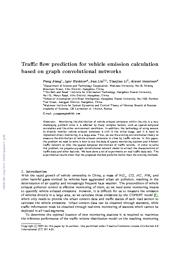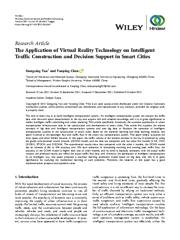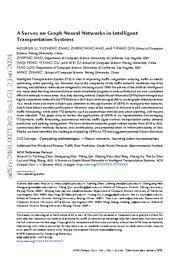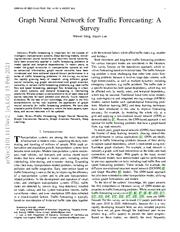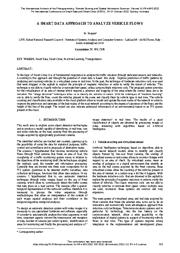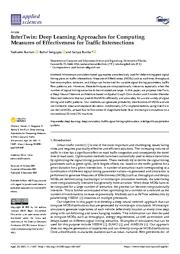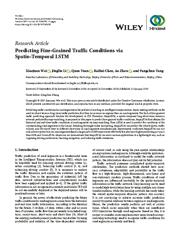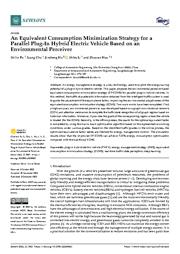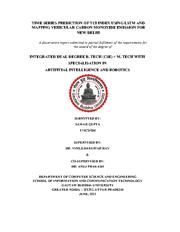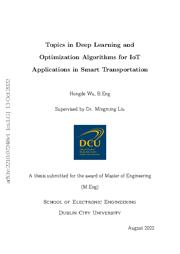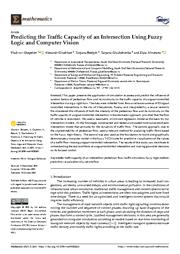A copy of this work was available on the public web and has been preserved in the Wayback Machine. The capture dates from 2021; you can also visit the original URL.
The file type is application/pdf.
Filters
Traffic flow prediction for vehicle emission calculation based on graph convolutional networks
2021
1st International Workshop on Advanced Information and Computation Technologies and Systems 2020
unpublished
In order to solve this problem, we propose a graph convolutional network model to extract the characteristics of traffic data and other features. ...
Thus, we use the existing environmental theory to measure the distribution of vehicle exhaust emissions in cities by traffic volume. ...
and traffic status of each road section to calculate the vehicle emissions. ...
doi:10.47350/aicts.2020.10
fatcat:rx5aqyirbzbx5gage6fpo3beq4
The Application of Virtual Reality Technology on Intelligent Traffic Construction and Decision Support in Smart Cities
2021
Wireless Communications and Mobile Computing
In this paper, the traffic volume of the random sections in the city is predicted by using the graph convolutional neural network (GCNN) model, and the data are compared with the other five models (VAR ...
Based on the machine learning and deep learning method, this paper is aimed at the passenger flow and traffic flow in the smart city transportation system. ...
Acknowledgments This work was supported by the Youth Fund Project of Wuhan Donghu University: Research on the construction of consumer purchase decision function based on live broadcast with goods, and ...
doi:10.1155/2021/3833562
fatcat:4iepfkoczvhjreuv3zkr6dwema
A Survey on Graph Neural Networks in Intelligent Transportation Systems
[article]
2024
arXiv
pre-print
This paper aims to review the applications of GNNs in six representative and emerging ITS domains: traffic forecasting, autonomous vehicles, traffic signal control, transportation safety, demand prediction ...
However, most of the research in this area is still concentrated on traffic forecasting, while other ITS domains, such as autonomous vehicles and urban planning, still require more attention. ...
Acknowledgments The authors are grateful to the anonymous reviewers for critically reading the manuscript and for giving important suggestions to improve their paper. ...
arXiv:2401.00713v2
fatcat:k7yta6x3ojd7doaq77kf3lykja
Graph Neural Network for Traffic Forecasting: A Survey
[article]
2022
arXiv
pre-print
In this survey, we review the rapidly growing body of research using different graph neural networks, e.g. graph convolutional and graph attention networks, in various traffic forecasting problems, e.g ...
To the best of our knowledge, this paper is the first comprehensive survey that explores the application of graph neural networks for traffic forecasting problems. ...
Urban vehicle emission: while not directly related to traffic states, the prediction of urban vehicle emission is considered in [226] . ...
arXiv:2101.11174v4
fatcat:txrrk6yia5dcvcamabhqahsrni
A SMART DATA APPROACH TO ANALYZE VEHICLE FLOWS
2022
The International Archives of the Photogrammetry, Remote Sensing and Spatial Information Sciences
of the road network according to the degree of saturation of the flows and the length of the line of the graph. ...
According to this approach and through the potential of smart data is based this study. Improve prediction of traffic patterns by analyzing and counting vehicles in a virtualized scene in real time. ...
The search for network traffic characteristics is based on the theory of time series analysis, which is aimed at models of traffic prediction. ...
doi:10.5194/isprs-archives-xlviii-4-w5-2022-105-2022
fatcat:qt7q3sdkojdn3dldrcomvuasyy
InterTwin: Deep Learning Approaches for Computing Measures of Effectiveness for Traffic Intersections
2021
Applied Sciences
In this paper, we propose InterTwin, a Deep Neural Network architecture based on Spatial Graph Convolution and Encoder-Decoder Recurrent networks that can predict the MOEs efficiently and accurately for ...
Microscopic simulation-based approaches are extensively used for determining good signal timing plans on traffic intersections. ...
: Spatio Temporal Graph Convolution Network for traffic prediction, as proposed in [21];
Figure 4 . 4 Figure 4. ...
doi:10.3390/app112411637
fatcat:fbkv22aivvcqhltxznpyd56oai
How to Build a Graph-Based Deep Learning Architecture in Traffic Domain: A Survey
[article]
2020
arXiv
pre-print
We first give guidelines to formulate a traffic problem based on graph and construct graphs from various kinds of traffic datasets. ...
Traditionally, convolution neural networks (CNNs) are utilized to model spatial dependency by decomposing the traffic network as grids. However, many traffic networks are graph-structured in nature. ...
ACKNOWLEDGMENT The authors would like to thank anonymous reviewers for their valuable comments. This work is supported in part by the National Key ...
arXiv:2005.11691v6
fatcat:uiso5cg6cvhvnfmtisvuxapfqi
Predicting Fine-Grained Traffic Conditions via Spatio-Temporal LSTM
2019
Wireless Communications and Mobile Computing
Predicting traffic conditions for road segments is the prelude of working on intelligent transportation. ...
Many existing methods can be used for short-term or long-term traffic prediction, but they focus more on regions than on road segments. ...
Although the constructed affinity graph can characterize the similarities among roads based similar speed patterns, the factors influencing traffic flow are not only the speed of vehicles, but also the ...
doi:10.1155/2019/9242598
fatcat:qsut6ankozdwvokrqpnyyzcyoa
Estimating On-road Transportation Carbon Emissions from Open Data of Road Network and Origin-destination Flow Data
[article]
2024
arXiv
pre-print
data and the road network data, to build a hierarchical heterogeneous graph learning method for on-road carbon emission estimation (HENCE). ...
However, existing estimation methods typically depend on hard-to-collect individual statistics of vehicle miles traveled to calculate emissions, thereby suffering from high data collection difficulty. ...
Roadway-based methods monitor flows on each road to calculate the corresponding total vehicle miles traveled, while vehicle-based methods aggregate individual vehicle trajectory statistics to obtain the ...
arXiv:2402.05153v1
fatcat:pbu4x2ys6jbulgyb4c4soknqha
Deep Learning on Traffic Prediction: Methods, Analysis and Future Directions
[article]
2021
arXiv
pre-print
The purpose of this paper is to provide a comprehensive survey on deep learning-based approaches in traffic prediction from multiple perspectives. ...
Traffic prediction plays an essential role in intelligent transportation system. Accurate traffic prediction can assist route planing, guide vehicle dispatching, and mitigate traffic congestion. ...
Spatial-based graph convolution network. Each node in the graph can represent a region in the traffic network. ...
arXiv:2004.08555v3
fatcat:ovhhumph2vbezpvc5m6qlk3udq
An Equivalent Consumption Minimization Strategy for a Parallel Plug-In Hybrid Electric Vehicle Based on an Environmental Perceiver
2022
Sensors
First, a high-accuracy environmental perceiver was developed based on a graph convolutional network (GCN) and attention mechanism to complete the traffic state recognition of all graph regions based on ...
Based on the identified traffic grades in the online process, the optimized equivalence factor tables are checked for energy management control. ...
The graph convolutional neural network is based on the constructed graph network to perform aggregation and map each node input. ...
doi:10.3390/s22249621
pmid:36559989
pmcid:PMC9783941
fatcat:muyvzzx735glzm5bnurys4kwvu
TIME SERIES PREDICTION OF TCI INDEX USING LSTM AND MAPPING VEHICULAR CARBON MONOXIDE EMISSION FOR NEW DELHI
2023
Zenodo
The study offers a unique method for creating high-resolution traffic emission inventories that can be used in many different cities, especially those that face a scarcity of publicly available data. ...
This text discusses various approaches for prediction, including statistical and machine-learning techniques, and the mapping of road-level vehicular emissions. ...
neural network techniques such as Convolutional Neural Network (CNN) and Long Short Term Memory (LSTM) networks for short term traffic flow prediction based on multivariate analysis. ...
doi:10.5281/zenodo.7539616
fatcat:c3sa64lnebejnhol7nqahpr5n4
Traffic flow prediction based on electric alarm data analysis
2022
jecet
network model based on the electric alarm data is constructed to predict the traffic flow at the entrance of the intersection. ...
It is urgent to develop accurate and fast traffic flow prediction methods to achieve efficient and intelligent traffic flow organization. ...
Zhang [5] proposed a new deep learning model, that is, the dynamic graph convolution network (STDE-DGCN) based on spatiotemporal data embedding. ...
doi:10.24214/jecet.c.11.4.56876
fatcat:gg7mxvnamvaixkbs44dm4x2lgq
Topics in Deep Learning and Optimization Algorithms for IoT Applications in Smart Transportation
[article]
2022
arXiv
pre-print
., attention-based spatial temporal graph convolutional network (AST-GCN), to improve the prediction accuracy in real world datasets. ...
In the second topic, we leverage graph neural network (GNN) for demand prediction for shared bikes. ...
We
Traffic Flow on Graph In this section, we introduce the processing of highway traffic flow with graph modelling. ...
arXiv:2210.07246v1
fatcat:oh6kylo3dfg3va5h7clu4bgzii
Predicting the Traffic Capacity of an Intersection Using Fuzzy Logic and Computer Vision
2021
Mathematics
The second approach, due to the unpredictability of pedestrian flow, used a relevant method for analysing traffic flows based on the fuzzy logic theory. ...
This paper presents the application of simulation to assess and predict the influence of random factors of pedestrian flow and its continuity on the traffic capacity of a signal-controlled intersection ...
The predictive model for assessing the influence of the total pedestrian flow and its continuity on the traffic capacity of an intersection is based on the fuzzy logic method and the programme fuzzyTECH ...
doi:10.3390/math9202631
fatcat:tb2qwv66c5boxpi2vc4fvgh7hi
« Previous
Showing results 1 — 15 out of 1,102 results

